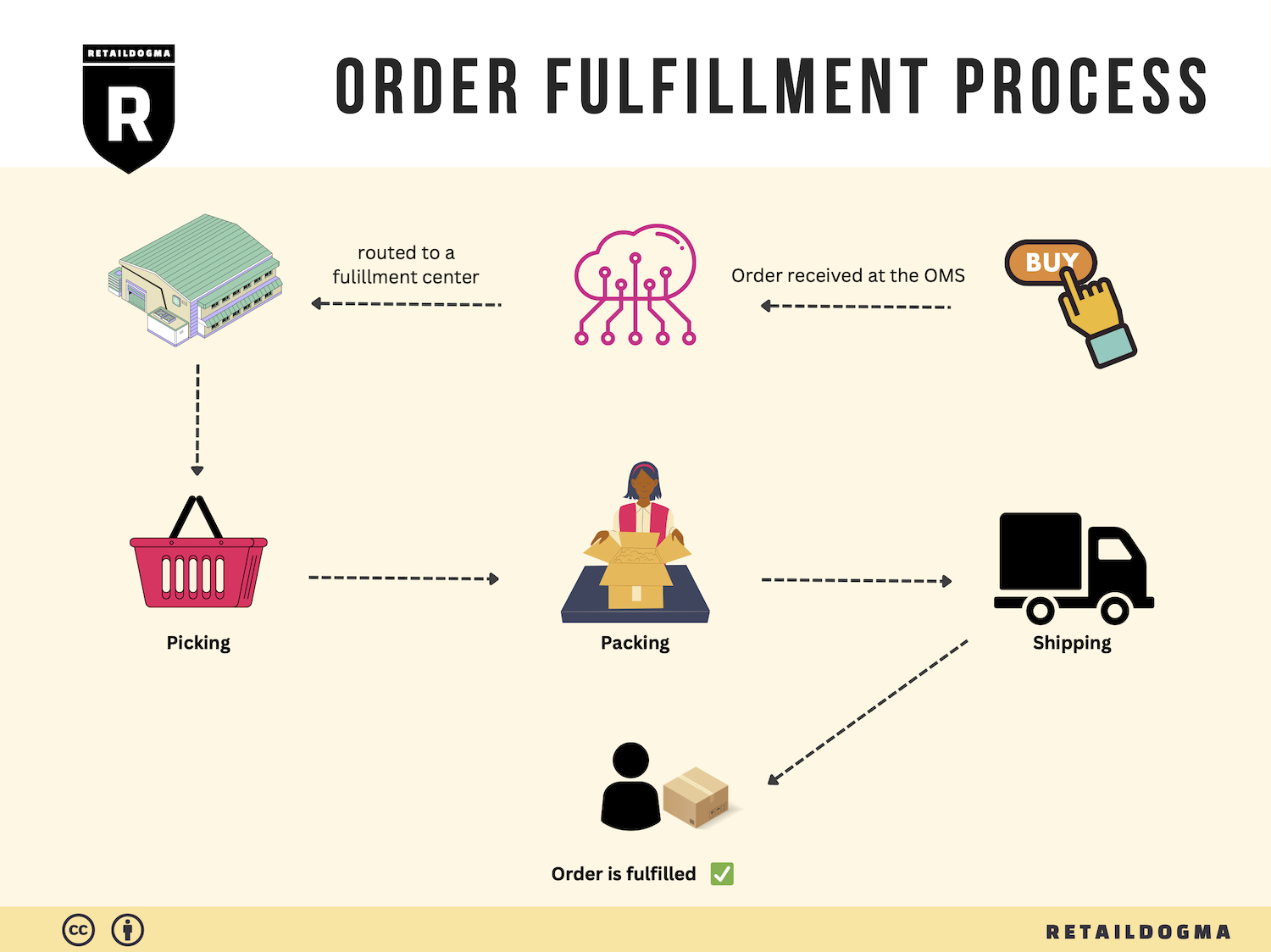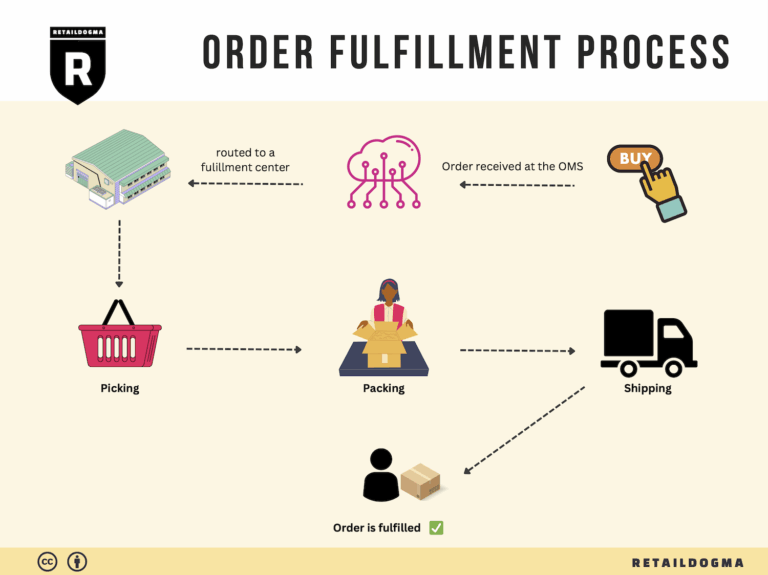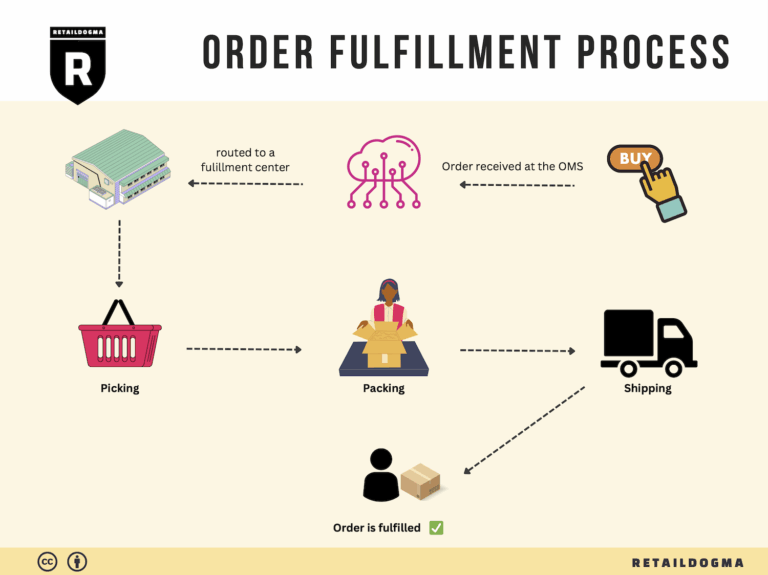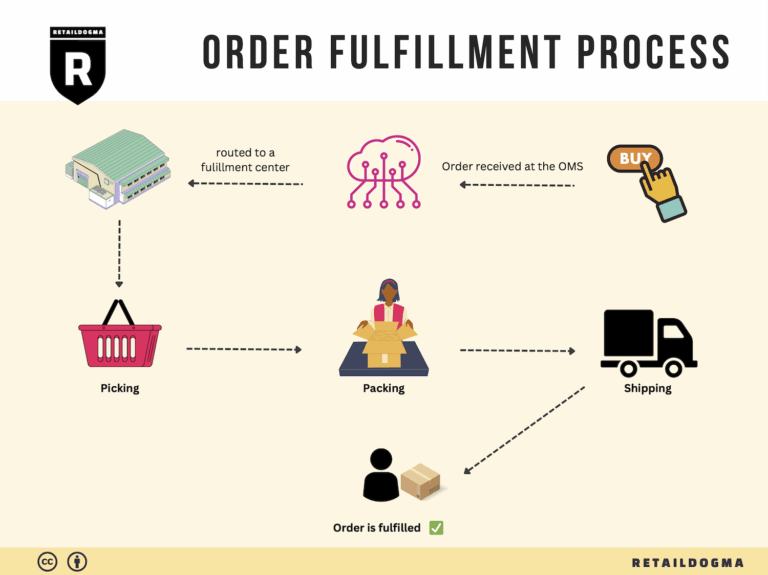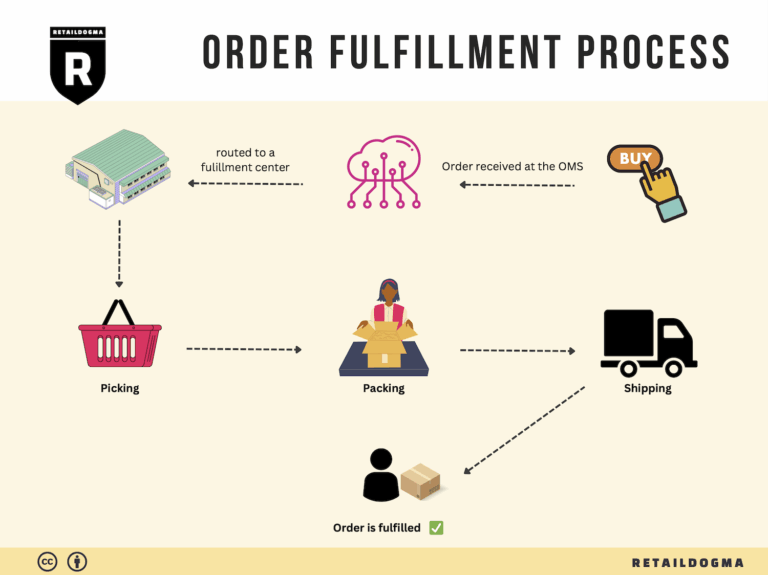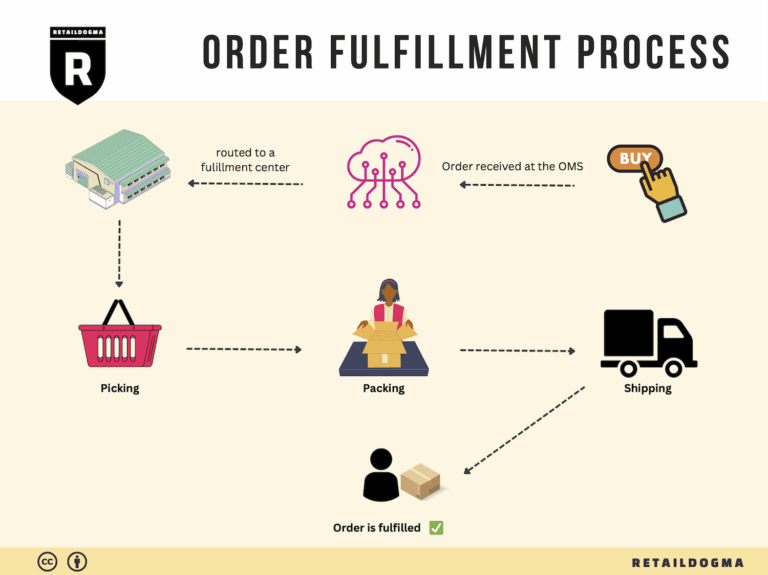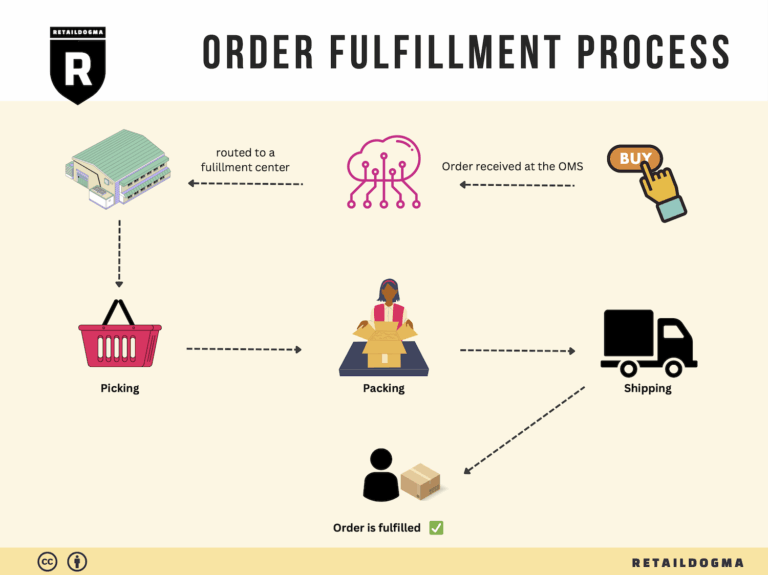How Order Fulfillment Works: A Step-by-Step Guide for Businesses
What is E-commerce Fulfillment? An Introduction for Growing Businesses
Understanding E-commerce Fulfillment: A Key to Business Growth
As an e-commerce business owner, you may find yourself grappling with the complexities of packing and shipping orders. The excitement of sales can quickly turn into overwhelm as you navigate inventory management, order processing, and timely deliveries. This is a common pain point for many growing online businesses, where the logistics of getting products to customers can become a significant challenge.
E-commerce fulfillment is the process of getting a product from your inventory to your customer’s doorstep. It encompasses several key steps, including receiving inventory, storing products, picking and packing orders, and shipping them out. Mastering this process is crucial for enhancing customer satisfaction and scaling your business effectively.
In this guide, we will explore various fulfillment models that can streamline your operations. You’ll learn about Third-Party Logistics (3PL) providers, which offer comprehensive services by managing storage, packing, and shipping on your behalf. We will also discuss Fulfillment by Amazon (FBA), where Amazon takes care of storage and shipping for you, allowing you to leverage their vast distribution network. Each model has its unique advantages and can suit different business needs, depending on your product type and sales volume.
Beyond the models, we will delve into the core services associated with e-commerce fulfillment. Understanding these services—from inventory management and order tracking to returns handling—will enable you to choose the right partner to align with your business goals.
Choosing the right fulfillment partner is a critical decision. We’ll provide practical criteria to evaluate potential partners, including their technology capabilities, shipping options, scalability, and customer service. Additionally, we’ll cover pricing structures commonly used in the industry, helping you to assess costs and determine the best value for your investment.

The ultimate goal of this guide is to empower you with the knowledge and tools to make informed decisions about your logistics strategy. By optimizing your e-commerce fulfillment processes, you can enhance operational efficiency, improve customer experiences, and position your business for sustainable growth. Let’s embark on this journey to simplify your fulfillment challenges and unlock new opportunities for success.
What You’ll Learn In This Guide
- What is E-commerce Fulfillment? An Introduction for Growing Businesses
- The Order Fulfillment Process: From ‘Buy’ Button to Customer’s Door
- Comparing Fulfillment Models: In-House vs. 3PL vs. Dropshipping
- A Deep Dive into Amazon FBA: Pros, Cons, and Who It’s For
- Core Services Offered by Fulfillment Centers
- How to Choose a Fulfillment Partner: A 6-Point Checklist
- Understanding Fulfillment Pricing: A Breakdown of Common Fees
- Frequently Asked Questions (FAQs) about Fulfillment
- Conclusion: Is Outsourcing Fulfillment the Right Move for Your Business?
- Important Disclaimer
The Order Fulfillment Process: From ‘Buy’ Button to Customer’s Door
1. Receiving Inventory
The first step in the order fulfillment process is receiving inventory. When products arrive at the fulfillment center, they are carefully unloaded and inspected for quality and accuracy. This is a critical stage because it ensures that the right items are in stock and in good condition, ready for storage and order processing. During this phase, items are assigned a Stock Keeping Unit (SKU), a unique identifier that helps in tracking inventory levels and managing stock efficiently.
Effective inventory receiving is crucial for maintaining optimal stock levels and reducing the risk of stockouts, which can lead to lost sales and dissatisfied customers. Properly received inventory also supports accurate record-keeping, which is essential for forecasting demand and making informed purchasing decisions.
2. Warehouse Storage
Once inventory has been received and processed, it moves to the warehouse storage phase. Here, products are organized and stored systematically within the fulfillment center. This organization is typically based on a combination of factors such as product size, demand frequency, and SKU categorization. Key terms associated with this step include “bin locations” and “warehouse management systems (WMS).”
The importance of effective warehouse storage cannot be overstated. A well-organized storage system allows for quick access to items, minimizing the time employees spend searching for products. This efficiency directly impacts order fulfillment speed, which is a competitive advantage in the e-commerce landscape. Moreover, effective storage practices help in managing inventory levels, reducing excess stock, and minimizing carrying costs.
3. Order Picking
Order picking is the process of selecting items from storage to fulfill customer orders. This step is often facilitated by pick lists, which are generated based on incoming orders and guide staff on which items to collect. Depending on the fulfillment center’s technology, order picking can be done manually or with the assistance of automated systems, including robots like Amazon’s Hercules and Pegasus.
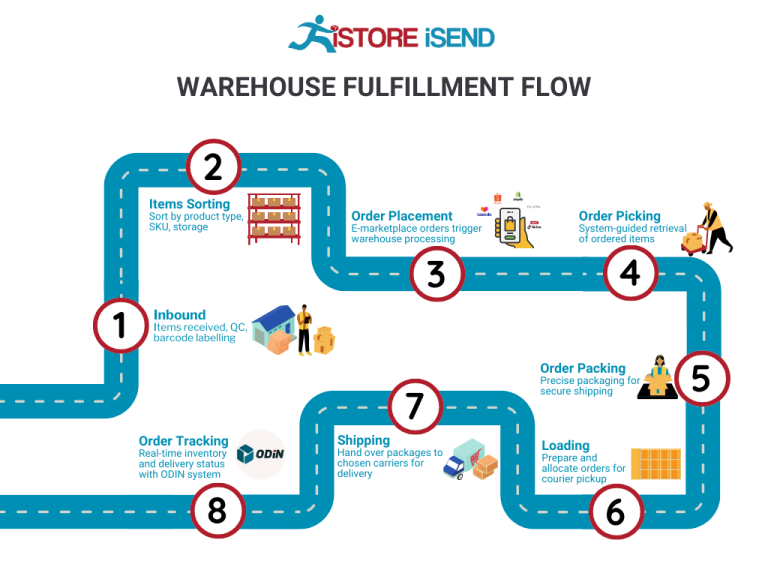
The significance of order picking lies in its direct impact on order accuracy and efficiency. Accurate picking ensures that customers receive the correct items, which is vital for customer satisfaction and return reduction. Additionally, the speed of the picking process influences overall order fulfillment times, making it essential for businesses aiming to meet customer expectations, especially during peak shopping seasons.
4. Order Packing
After items have been picked, they move to the packing stage. Here, items are carefully packed into boxes or envelopes, often using packing materials to protect them during transit. This phase may also involve printing shipping labels and including packing slips. Key terms associated with packing include “dimensional weight” and “packaging optimization.”
The packing process is essential for ensuring that products arrive at their destination in pristine condition. Proper packing minimizes the risk of damage during shipping, which can lead to costly returns and dissatisfied customers. Furthermore, efficient packing strategies can help reduce shipping costs by minimizing package size and weight, thus enhancing overall profitability.
5. Shipping & Delivery
The final step in the order fulfillment process is shipping and delivery. Once packages are packed, they are sorted for shipment to various delivery destinations. In the case of Amazon’s Baton Rouge fulfillment center, packages are first sent to a sortation center before being dispatched to delivery stations and ultimately to customers’ doors. Key terms in this step include “last-mile delivery” and “carrier management.”
Shipping and delivery are critical components of the customer experience. The efficiency and reliability of this stage can significantly affect customer satisfaction and retention. Timely delivery not only fulfills customer expectations but also builds trust in the brand. As e-commerce continues to grow, optimizing shipping and delivery processes is paramount for businesses looking to scale and compete effectively in the market.
In conclusion, understanding and optimizing each step of the order fulfillment process is crucial for e-commerce businesses. From receiving inventory to shipping and delivery, each stage plays a vital role in ensuring a seamless experience for customers and maximizing operational efficiency. By focusing on these processes, businesses can enhance their scalability and meet the ever-increasing demands of the e-commerce landscape.
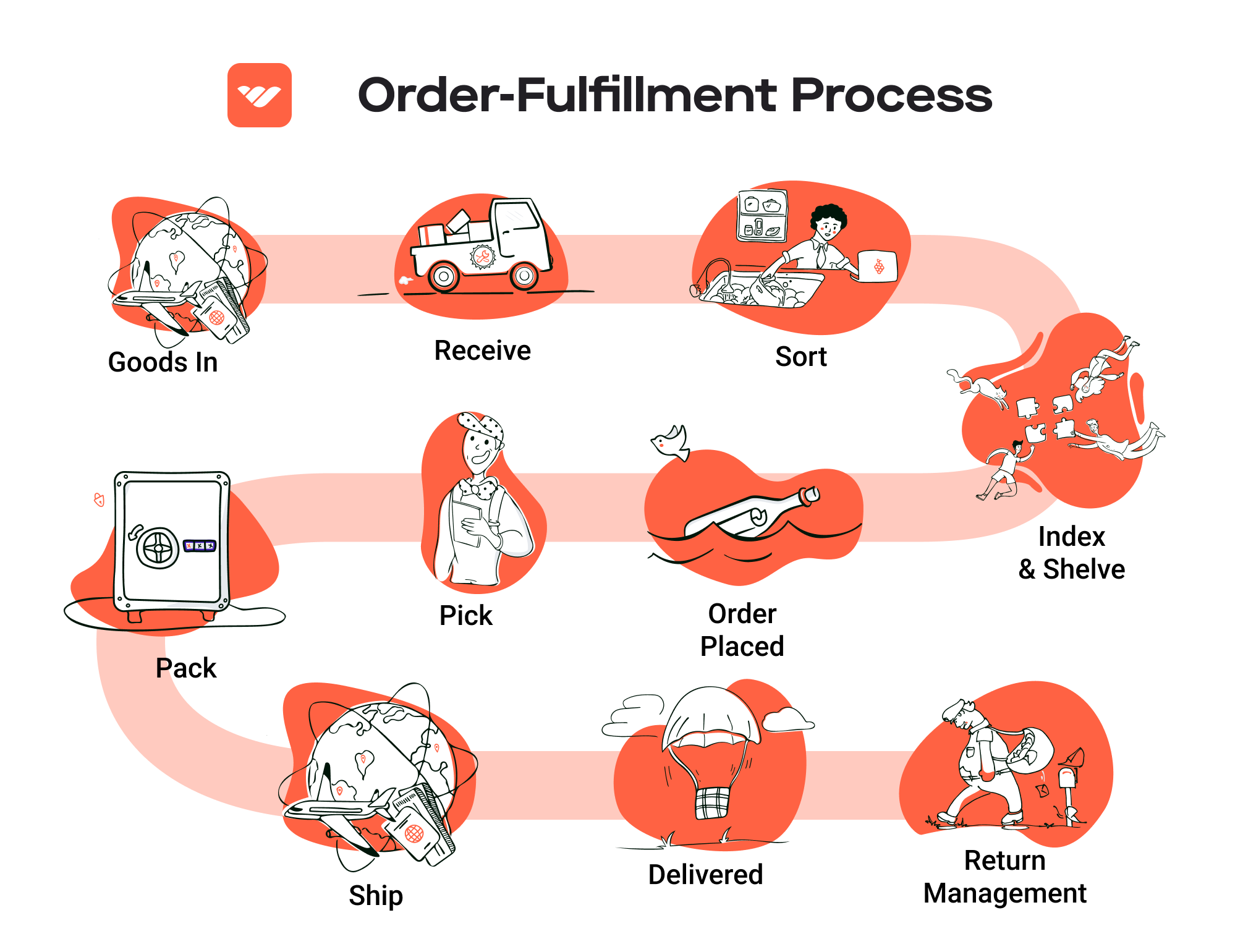
Comparing Fulfillment Models: In-House vs. 3PL vs. Dropshipping
Fulfillment Model Comparison
| Model | Who Handles Inventory | Best For (Business Stage) | Key Advantage | Key Disadvantage |
|---|---|---|---|---|
| In-House Fulfillment | The business itself | Established and growing businesses | Full control over inventory and fulfillment process | High overhead costs and resource allocation required |
| Third-Party Logistics (3PL) | A third-party provider | Startups and medium-sized businesses | Scalability and reduced operational burden | Less control over inventory and fulfillment speed |
| Dropshipping | Supplier or manufacturer | New businesses and niche markets | Low startup costs and minimal inventory risk | Lower profit margins and dependency on suppliers |
In-House Fulfillment
In-house fulfillment refers to the process where a business manages its own inventory and shipping operations within its own facilities. This model is best suited for established businesses that have sufficient sales volume and resources to support the logistics involved. The key advantage of in-house fulfillment is the level of control it offers; businesses can directly manage inventory levels, order processing, and shipping timelines, ensuring that customer expectations are met. This control can lead to improved customer satisfaction and brand loyalty. However, the downside includes significant overhead costs associated with maintaining a warehouse, hiring staff, and investing in technology and equipment necessary for efficient operations. Moreover, as demand fluctuates, businesses may struggle with either excess inventory or inadequate fulfillment capacity.
Third-Party Logistics (3PL)
Third-party logistics, commonly referred to as 3PL, involves outsourcing logistics operations to a specialized provider. This model is particularly beneficial for startups and medium-sized businesses that may not have the resources or expertise to handle logistics effectively. The main advantage of using a 3PL is scalability; businesses can easily adjust their logistics operations based on demand without the burden of managing the infrastructure. This allows companies to focus on their core competencies while benefiting from the expertise of logistics professionals. However, one of the key disadvantages is the potential loss of control over inventory and fulfillment processes. Businesses may face delays or inaccuracies that can impact customer satisfaction, especially if the 3PL provider does not align with the company’s operational standards.
Dropshipping
Dropshipping is a fulfillment model where the retailer does not hold inventory but instead transfers customer orders directly to the supplier, who then ships the products to the customer. This model is particularly appealing for new businesses and those operating in niche markets due to its low startup costs and minimal inventory risk. Entrepreneurs can start selling products without the need for a large upfront investment in inventory or warehousing. However, dropshipping comes with its own set of challenges. The profit margins are often lower compared to traditional retail because the retailer pays the supplier a wholesale price while selling at retail. Additionally, businesses are reliant on suppliers for inventory management, shipping times, and product quality, which can lead to customer dissatisfaction if issues arise. This dependency can also create challenges in building a strong brand identity, as the retailer has less control over the customer experience.
In conclusion, choosing the right fulfillment model depends largely on the stage of your business, your operational capacity, and your strategic goals. Understanding the nuances of each model will help you make informed decisions that can significantly impact your e-commerce success. Whether you’re considering in-house fulfillment for greater control, leveraging a 3PL for scalability, or opting for dropshipping to minimize risk, each model has its advantages and disadvantages that must be weighed carefully against your business objectives.
A Deep Dive into Amazon FBA: Pros, Cons, and Who It’s For
Understanding Fulfillment by Amazon (FBA)
Fulfillment by Amazon (FBA) is a service provided by Amazon that allows sellers to store their products in Amazon’s fulfillment centers. Amazon takes care of storage, packaging, shipping, and customer service for these products. This system leverages Amazon’s extensive logistics network to help sellers reach a broader audience, particularly those who are part of Amazon Prime, which offers expedited shipping options.
When a customer places an order for a product fulfilled by FBA, Amazon handles the entire process—from picking the item off the shelf to packaging and shipping it directly to the customer. This not only simplifies the logistics for sellers but also enhances the customer experience by ensuring fast and reliable delivery.
How FBA Works
- Product Listing: Sellers create a product listing on Amazon and select the FBA option.
- Inventory Shipment: Sellers send their inventory to Amazon’s fulfillment centers. This can be done in bulk, and sellers are advised on how to package and label their products.
- Storage: Once received, Amazon stores the products in their warehouses.
- Order Fulfillment: When a customer orders a product, Amazon picks, packs, and ships the item from their warehouse.
- Customer Service: Amazon also manages customer service and returns for those orders, providing a seamless experience for both sellers and customers.
Pros of Using FBA
Prime Eligibility
One of the biggest advantages of FBA is that products fulfilled by Amazon are eligible for Amazon Prime, which attracts millions of customers who prefer the convenience of fast, free shipping. This can significantly increase a seller’s visibility and sales volume.
Customer Trust
Amazon is a trusted name in e-commerce, and by using FBA, sellers benefit from that trust. Customers are more likely to purchase products that are fulfilled by Amazon because they associate it with reliability, quality service, and easier return processes.
Multi-Channel Fulfillment
FBA isn’t limited to just Amazon sales. Sellers can use FBA to fulfill orders from their own websites or other sales channels, giving them a cohesive logistics solution. This multi-channel fulfillment capability allows sellers to streamline their operations and focus on growth.
Cons of Using FBA
High Fees
While FBA offers many advantages, it comes with its share of costs. Sellers must pay for storage and fulfillment fees, which can add up quickly, especially for products that don’t sell as fast as anticipated. These fees can significantly eat into profit margins, making it crucial for sellers to carefully calculate their costs before opting for FBA.
Strict Inventory Rules
Amazon has specific guidelines regarding inventory management, including limits on how much inventory can be stored and how long it can remain in their fulfillment centers. Sellers who do not adhere to these guidelines may incur additional fees or have their products removed from the platform. This can create challenges, especially for sellers with seasonal products or those experiencing fluctuating demand.
Commingling Risks
When using FBA, sellers’ products may be commingled with those of other sellers. This means that if there is an issue with one seller’s product, it could affect the reputation of others. For example, if a customer receives a damaged or defective item from a different seller’s stock, it could lead to negative reviews for your product, even if your inventory is in perfect condition.
Who is FBA Best For?
FBA is particularly well-suited for:
- Small to Medium-Sized Sellers: Those who may not have the resources to manage logistics on their own can benefit from Amazon’s infrastructure and expertise.
- E-commerce Startups: New businesses looking to scale quickly and gain access to Amazon’s vast customer base can find FBA an advantageous option.
- Retailers with High Inventory Turnover: Sellers who sell fast-moving consumer goods can leverage FBA to manage inventory efficiently and keep costs down.
- Businesses Looking for Multi-Channel Fulfillment: Companies that sell through multiple platforms can streamline their logistics by using FBA for all their fulfillment needs.
In conclusion, Fulfillment by Amazon offers a powerful solution for sellers looking to enhance their logistics capabilities and reach a larger audience. While it comes with its own set of challenges and costs, the potential benefits, including increased visibility and customer trust, can make it a worthwhile investment for many e-commerce businesses. As with any business decision, careful consideration and planning are essential to maximize the advantages of FBA while mitigating its downsides.
Core Services Offered by Fulfillment Centers
Inventory Management & Warehousing
Effective inventory management and warehousing are crucial components of e-commerce fulfillment that directly impact a business’s operational efficiency and customer satisfaction. Fulfillment centers utilize advanced technology and processes to monitor stock levels, track product movements, and manage storage space efficiently.
What It Is: Inventory management involves overseeing the flow of goods from manufacturers to warehouses and ultimately to customers. This includes tracking inventory levels, managing reorders, and ensuring that stock is available when needed. Warehousing refers to the storage of these goods in a facility designed for efficient retrieval and shipment.
Benefits to E-commerce Businesses:
1. Improved Accuracy: Automated inventory systems reduce human error, ensuring that businesses have accurate data on stock levels, which is essential for making informed purchasing decisions.
2. Cost Efficiency: By optimizing storage space and reducing excess inventory, businesses can lower holding costs and enhance cash flow.
3. Faster Order Fulfillment: With strategic warehousing locations, fulfillment centers can expedite shipping times, enhancing customer satisfaction and loyalty.
4. Scalability: As e-commerce businesses grow, fulfillment centers can easily adjust inventory management practices to meet increasing demand without the need for significant capital investment in logistics infrastructure.
Pick and Pack Services
Pick and pack services are vital for e-commerce operations, enabling businesses to fulfill customer orders efficiently and accurately.
What It Is: This service involves the process of selecting (or “picking”) the right products from inventory and packaging them for shipment. Fulfillment centers typically use advanced software and trained personnel to ensure that orders are picked accurately and packed securely.
Benefits to E-commerce Businesses:
1. Efficiency and Speed: Fulfillment centers streamline the picking process through organized storage systems and technology, allowing for quicker order processing and shipment.
2. Customization: Many fulfillment centers offer customizable packing options, such as branded packaging or gift wrapping, which can enhance the customer experience and strengthen brand identity.
3. Reduced Labor Costs: By outsourcing pick and pack operations, e-commerce businesses can reduce labor costs associated with hiring and training staff for these tasks.
4. Minimized Errors: With rigorous quality control measures in place, fulfillment centers reduce the risk of shipping errors, which can lead to costly returns and customer dissatisfaction.
Kitting and Assembly
Kitting and assembly services are essential for businesses that offer products that need to be packaged together or assembled before shipping.
What It Is: Kitting involves assembling multiple products into a single package or kit, while assembly refers to putting together components to create a finished product. These services are especially beneficial for businesses that sell subscription boxes, promotional kits, or products that require assembly.
Benefits to E-commerce Businesses:
1. Enhanced Product Offerings: Kitting allows businesses to offer bundled products at a discounted rate, increasing average order value and encouraging larger purchases.
2. Time Savings: By outsourcing kitting and assembly, businesses can save significant time and resources, allowing them to focus on core activities such as marketing and product development.
3. Increased Customer Satisfaction: Delivering assembled products or kits improves the customer experience by providing convenience and reducing the effort required from the customer.
4. Streamlined Inventory Management: Fulfillment centers can manage the inventory of both individual components and finished kits, simplifying stock management and reducing the risk of overstocking or stockouts.
Returns Management (Reverse Logistics)
Returns management, also known as reverse logistics, is a critical service that ensures the efficient handling of returned products, which is increasingly important in the e-commerce landscape.
What It Is: This service encompasses the processes involved in managing returns from customers, including receiving returned items, inspecting their condition, restocking, and processing refunds or exchanges.
Benefits to E-commerce Businesses:
1. Improved Customer Trust: A streamlined returns process enhances customer confidence in a business, knowing that they can return products easily if necessary, which can lead to increased sales.
2. Cost Reduction: Efficient returns management can minimize losses associated with returned goods by quickly assessing and restocking items that are still sellable.
3. Data Insights: Analyzing return data can provide valuable insights into product quality and customer preferences, helping businesses make informed decisions about inventory and product offerings.
4. Brand Loyalty: Exceptional returns management can differentiate a business from competitors, fostering customer loyalty and encouraging repeat purchases.
In summary, partnering with a fulfillment center that offers robust inventory management, efficient pick and pack services, kitting and assembly, and effective returns management can significantly enhance an e-commerce business’s operational capabilities, reduce costs, and improve customer satisfaction. By leveraging these core services, e-commerce businesses can scale their operations effectively while focusing on growth and innovation.
How to Choose a Fulfillment Partner: A 6-Point Checklist
Location & Warehouse Network
Importance: The geographical location of your fulfillment partner’s warehouses can significantly impact your shipping times, costs, and overall customer satisfaction. A partner with a well-distributed network of warehouses can facilitate faster deliveries and lower shipping expenses.
Questions to Ask:
– Where are your warehouses located, and how do they align with my target market?
– How many fulfillment centers do you operate, and what is the average distance from these centers to major shipping zones?
– Can you provide insights on your shipping capabilities to ensure timely deliveries?
Technology & Integrations
Importance: In today’s digital age, the technology used by your fulfillment partner is crucial for seamless operations. Effective inventory management, order tracking, and integration with your e-commerce platform can streamline processes and enhance customer experience.
Questions to Ask:
– What software and technology do you use for inventory management and order fulfillment?
– Can your systems integrate with my e-commerce platform (e.g., Shopify, Amazon, WooCommerce)?
– How do you handle real-time inventory updates and order tracking?
Specializations (e.g., cold storage, oversized items)
Importance: Depending on the nature of your products, you may require specialized services. Whether you’re selling perishable goods that need cold storage or oversized items that need specific handling, ensure your fulfillment partner has the necessary capabilities.
Questions to Ask:
– Do you have experience handling my specific product types (e.g., food, electronics, oversized items)?
– What specialized storage options do you offer (e.g., climate control, hazardous materials)?
– How do you ensure compliance with industry regulations related to my products?
Scalability & Capacity
Importance: As your business grows, your fulfillment needs will evolve. It’s essential to partner with a fulfillment provider that can scale operations to meet increased demand without compromising service quality.
Questions to Ask:
– How do you handle peak seasons and unexpected spikes in order volume?
– Can you provide examples of how you’ve scaled operations for other clients?
– What is your capacity for handling my projected growth over the next few years?
Pricing and Contracts
Importance: Understanding the pricing structure and contract terms is vital to avoid unexpected costs that can erode your profit margins. A transparent pricing model will help you budget effectively and make informed decisions.
Questions to Ask:
– Can you provide a detailed breakdown of your pricing model (e.g., storage fees, pick-and-pack fees, shipping costs)?
– What are the terms of your contracts, and are there any hidden fees?
– Do you offer flexible pricing options for seasonal businesses or long-term commitments?
Customer Support & Reviews
Importance: Reliable customer support is crucial for addressing any issues that arise during the fulfillment process. Additionally, reviewing testimonials and case studies can provide insight into the partner’s reliability and service quality.
Questions to Ask:
– What kind of customer support do you offer (e.g., dedicated account manager, 24/7 support)?
– Can you provide references or case studies from similar businesses?
– How do you handle complaints or fulfillment errors, and what is your process for resolution?
Conclusion
Choosing the right fulfillment partner is a critical decision that can affect your e-commerce business’s efficiency, customer satisfaction, and ultimately, your bottom line. Use this checklist as a guide to evaluate potential partners thoroughly. Assessing their capabilities in these six key areas will help ensure you select a fulfillment partner that aligns with your business goals and can support your growth effectively. Always remember to perform due diligence, seek references, and consider your unique business needs before making a final decision.
Understanding Fulfillment Pricing: A Breakdown of Common Fees
Initial Setup Fees
Initial setup fees are one-time costs associated with getting your account activated and your inventory integrated into the fulfillment center’s system. These fees can vary significantly depending on the fulfillment service provider and the complexity of your operations. Typically, they cover the costs of onboarding, including account setup, software integration, and initial training for your team on how to use the provider’s systems.
To calculate initial setup fees, providers may assess the volume of products you plan to store, the types of services you require (like custom packaging or kitting), and any specific needs unique to your business. It’s crucial to clarify what these fees include and whether there are any recurring charges associated with account maintenance.
Receiving Fees
Receiving fees are charged for the process of accepting your inventory into the fulfillment center. This fee usually encompasses the labor and technology costs involved in unloading, inspecting, and inputting your products into the warehouse management system.
Typically, receiving fees are calculated based on the volume of inventory being processed, measured in either units or pallets. For example, a provider might charge a flat fee per pallet received or a per-item fee for each unit that is checked into their system. It’s essential to ensure that you understand how these fees are structured, especially if you plan to send large shipments of inventory.
Storage Fees (per pallet/bin)
Storage fees are recurring charges for the space your inventory occupies within the fulfillment center. These fees can be calculated on a per-pallet or per-bin basis, depending on how the facility is organized. Generally, storage fees are billed monthly and can vary based on the type of inventory you are storing—some items may require special handling or climate control, which could increase your storage costs.
Providers often charge based on the amount of space your goods take up, with fees increasing for higher volumes of inventory. It’s beneficial to monitor your inventory turnover rates closely; slow-moving items can lead to increased storage fees over time.
Pick & Pack Fees (per item/order)
Pick and pack fees are incurred each time an order is fulfilled. This fee covers the labor and materials used to pick items from the warehouse, package them, and prepare them for shipping. Pick and pack fees can be structured in several ways: some providers charge a flat fee per order, while others may charge based on the number of items picked.
To calculate pick and pack fees, consider the complexity of your products. For instance, if your items require special packaging or assembly, the fees may be higher. Understanding the fee structure will help you optimize your order fulfillment process and potentially negotiate lower rates based on your order volume.
Shipping Fees
Shipping fees are the costs associated with transporting your products to the customer. These fees can vary based on several factors, including the shipping method chosen (standard, expedited, etc.), the destination of the shipment, and the dimensions and weight of the package.
Shipping fees are typically calculated based on a combination of weight and distance. Some fulfillment centers offer discounted shipping rates due to bulk agreements with carriers, which can benefit your bottom line. It’s wise to review the shipping options available through your fulfillment provider and assess how their rates compare to other carriers.
Tips for Getting an Accurate Quote
-
Provide Detailed Information: When requesting a quote, provide as much detail as possible about your inventory, order volume, and specific needs. This helps the provider give you a more accurate estimate.
-
Ask About Hidden Fees: Ensure you inquire about any additional fees that may not be included in the initial quote, such as fees for returns, special handling, or seasonal surcharges.
-
Compare Multiple Providers: Don’t settle for the first quote you receive. Compare offerings from multiple fulfillment centers to understand the market rates and find the best fit for your business.
-
Negotiate Terms: If you anticipate high order volumes, use this as leverage to negotiate lower rates or more favorable terms.
-
Review Contracts Carefully: Before signing any agreement, review the contract thoroughly to ensure you understand all fees and terms involved.
By understanding these common fulfillment pricing models and following these tips, you can effectively manage your costs and streamline your e-commerce operations, setting your business up for successful scaling.
Frequently Asked Questions (FAQs) about Fulfillment
1. What is the Amazon Fulfillment Center in Baton Rouge?
The Amazon Fulfillment Center in Baton Rouge, known as BTR 1, is a state-of-the-art logistics facility located at the former Cortana Mall site. This facility primarily focuses on processing and shipping packages efficiently using advanced robotics and automation technology.
2. How does the fulfillment process work at the Baton Rouge center?
The fulfillment process at the Baton Rouge center involves several key steps:
1. When a customer places an order, the item is located in the fulfillment center using advanced robots.
2. Employees retrieve the items and package them for shipment.
3. The packages are then transported via robots to delivery trucks.
4. Finally, packages are sent to sortation centers before reaching customers.
3. What types of robots are used in the Baton Rouge fulfillment center?
The Baton Rouge fulfillment center employs various robots, including:
– Hercules Robots: These are used to transport tall stacks of bins containing products.
– Pegasus Robots: These robots feature a conveyor belt and transport packaged items to delivery trucks.
– Robin Robots: Equipped with metal arms and suction cups, these robots assist in picking up heavy packages when needed.
4. What’s the difference between a warehouse and a fulfillment center?
A warehouse is primarily used for storing goods, while a fulfillment center is designed for processing orders and shipping products directly to customers. Fulfillment centers focus on efficiency and speed, utilizing technology to manage inventory and streamline the shipping process.
5. How much do fulfillment services cost?
Fulfillment service costs can vary widely based on several factors, including order volume, product type, and specific services required (like kitting or custom packaging). Typically, businesses can expect to pay for storage space, picking and packing fees, and shipping costs. It’s advisable to consult with fulfillment service providers for tailored pricing based on your business needs.
6. What is a 3PL (Third-Party Logistics)?
A 3PL, or Third-Party Logistics provider, is a company that offers outsourced logistics services, which can include transportation, warehousing, and fulfillment. Partnering with a 3PL allows businesses to focus on core operations while leveraging the expertise and infrastructure of a logistics provider.
7. How many packages does the Baton Rouge fulfillment center handle daily?
The Baton Rouge fulfillment center processes approximately 90,000 packages daily, with the capacity to handle up to 300,000 packages during peak times, such as holiday seasons or significant sales events like Amazon Prime Day.
8. What employment opportunities are available at the Baton Rouge fulfillment center?
The fulfillment center currently employs around 800 workers, with plans to increase staffing to over 1,000. Job opportunities include roles in operations management, fulfillment associates, robotics technicians, and safety specialists, among others.
9. How does the Baton Rouge fulfillment center impact the local economy?
The fulfillment center is expected to have a significant economic impact on the Baton Rouge area, creating over 1,000 jobs and generating substantial tax revenue. The facility also contributes to revitalizing the local economy by transforming a previously blighted area into a modern logistics hub.
10. What advantages does Baton Rouge offer as a logistics hub?
Baton Rouge’s strategic location offers several advantages for logistics, including proximity to major highways, ports, and rail systems. Its central position within a day’s drive of major cities like Atlanta and Houston enhances its appeal for e-commerce businesses looking to optimize their distribution networks.
Conclusion: Is Outsourcing Fulfillment the Right Move for Your Business?
The Strategic Advantage of Outsourcing Fulfillment
Outsourcing fulfillment can be a transformative decision for your e-commerce business. The key benefits include significant time savings, enhanced scalability, and access to specialized expertise. By partnering with a fulfillment service, you can focus on core business activities such as marketing and product development, rather than getting bogged down in the logistics of inventory management and shipping. This shift not only streamlines operations but also allows you to respond swiftly to market demands and seasonal fluctuations.
Scalability is another critical advantage. As your business grows, so do the complexities of managing order fulfillment. A robust fulfillment partner can seamlessly adjust to your increasing order volumes, ensuring that you maintain high service levels without the need for substantial investment in infrastructure or labor. This flexibility is vital in today’s fast-paced e-commerce environment, where consumer expectations for rapid delivery continue to rise.
Moreover, leveraging the expertise of a fulfillment partner can lead to improved operational efficiencies. Established fulfillment centers, like the new Amazon facility in Baton Rouge, utilize cutting-edge technology and processes that can significantly enhance order accuracy and speed. This level of sophistication is often beyond the reach of smaller businesses, making outsourcing a smart choice.
However, the success of outsourcing fulfillment hinges on selecting the right partner. It’s essential to evaluate potential partners based on their capabilities, technology, and track record of customer service.
As a strategic call-to-action, take a moment to audit your current shipping and fulfillment processes. Are they scalable? Are they efficient? Identifying gaps or inefficiencies may illuminate whether a fulfillment partner could be the next step in your growth journey. Embracing this change could position your business for greater success in an increasingly competitive landscape.
Important Disclaimer
⚠️ Important Disclaimer
The information in this guide is for educational purposes. Fulfillment services, pricing, and platform features change frequently. Always conduct your own due diligence and consult with providers directly before making business decisions.
